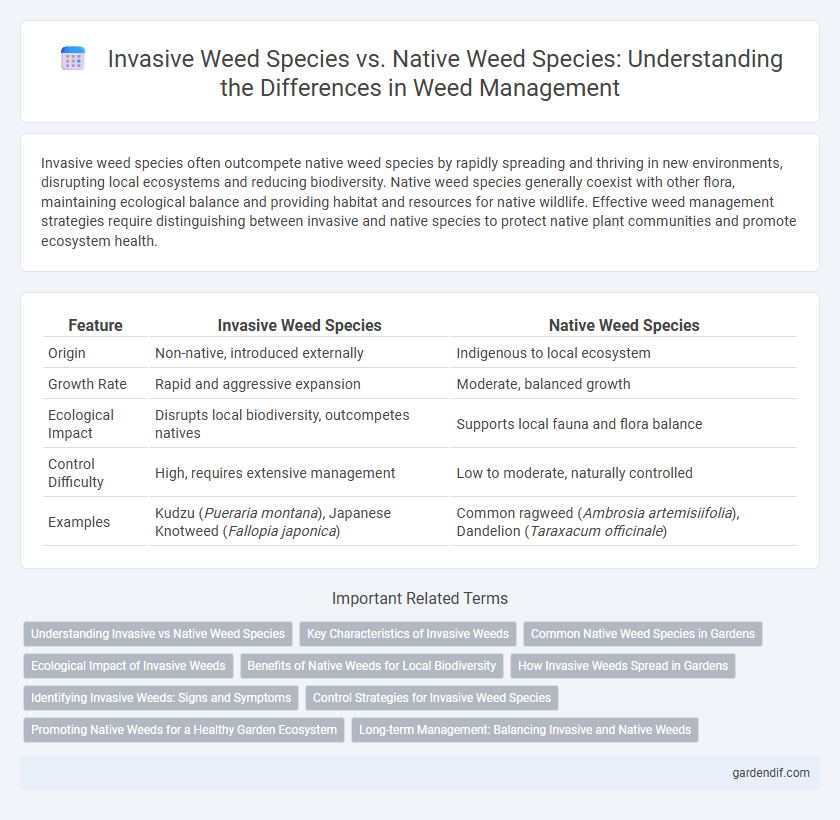
Invasive weed species vs Native weed species Illustration
Invasive weed species often outcompete native weed species by rapidly spreading and thriving in new environments, disrupting local ecosystems and reducing biodiversity. Native weed species generally coexist with other flora, maintaining ecological balance and providing habitat and resources for native wildlife. Effective weed management strategies require distinguishing between invasive and native species to protect native plant communities and promote ecosystem health.
Table of Comparison
| Feature | Invasive Weed Species | Native Weed Species |
|---|---|---|
| Origin | Non-native, introduced externally | Indigenous to local ecosystem |
| Growth Rate | Rapid and aggressive expansion | Moderate, balanced growth |
| Ecological Impact | Disrupts local biodiversity, outcompetes natives | Supports local fauna and flora balance |
| Control Difficulty | High, requires extensive management | Low to moderate, naturally controlled |
| Examples | Kudzu (Pueraria montana), Japanese Knotweed (Fallopia japonica) | Common ragweed (Ambrosia artemisiifolia), Dandelion (Taraxacum officinale) |
Understanding Invasive vs Native Weed Species
Invasive weed species disrupt local ecosystems by outcompeting native plants for resources, often leading to reduced biodiversity and altered habitat structures. Native weed species, while sometimes considered undesirable, typically coexist within their ecosystems and provide essential functions, such as soil stabilization and supporting native wildlife. Effective weed management requires distinguishing invasive species like kudzu or Japanese knotweed from native weeds to protect ecological balance and promote sustainable land use.
Key Characteristics of Invasive Weeds
Invasive weed species exhibit rapid growth, high seed production, and efficient dispersal mechanisms, enabling them to outcompete native plants and dominate ecosystems. They often possess adaptive traits such as tolerance to diverse environmental conditions and allelopathic chemicals that inhibit neighboring plant growth. These characteristics contribute to their persistence and significant impact on biodiversity and agricultural productivity.
Common Native Weed Species in Gardens
Common native weed species in gardens, such as dandelions (Taraxacum officinale), clover (Trifolium spp.), and plantain (Plantago major), play crucial roles in maintaining soil health and supporting pollinators. These native weeds often have deep root systems that improve soil aeration and nutrient cycling while providing habitat for beneficial insects. Unlike invasive species, native weeds coexist with local flora and fauna, contributing to ecological balance and garden biodiversity.
Ecological Impact of Invasive Weeds
Invasive weed species disrupt native ecosystems by outcompeting indigenous plants for resources, leading to reduced biodiversity and altered habitat structures. These species often lack natural predators, allowing them to spread rapidly and dominate landscapes, which can negatively impact soil health and water availability. Native weed species, conversely, tend to maintain ecological balance by coexisting with other flora and fauna, supporting overall ecosystem stability.
Benefits of Native Weeds for Local Biodiversity
Native weed species support local biodiversity by providing essential habitat and food sources for indigenous insects, birds, and other wildlife. These plants contribute to soil health through natural nutrient cycling and promote ecosystem stability by maintaining native plant community balance. Unlike invasive weeds, native species prevent the displacement of endemic flora and reduce the risk of ecological disruption.
How Invasive Weeds Spread in Gardens
Invasive weed species spread rapidly in gardens through efficient seed dispersal mechanisms such as wind, water, and animal carriers, outcompeting native weed species. Their aggressive growth patterns and lack of natural predators enable them to dominate garden ecosystems, altering soil nutrients and plant diversity. Effective management requires identifying invasive species early and implementing physical removal or targeted herbicides to prevent their establishment and spread.
Identifying Invasive Weeds: Signs and Symptoms
Invasive weed species often exhibit rapid growth, aggressive spreading patterns, and the ability to outcompete native vegetation for resources such as sunlight, water, and nutrients. Signs include dense monocultures, altered soil chemistry, and reduced biodiversity in affected areas, while symptoms may involve stunted growth or stress in native plants. Identifying invasive weeds early through leaf shape, flower structure, and seed dispersal methods enables effective management and prevents ecological imbalance.
Control Strategies for Invasive Weed Species
Invasive weed species often outcompete native vegetation, threatening biodiversity and ecosystem balance, necessitating targeted control strategies such as mechanical removal, chemical herbicides, and biological controls like introducing natural predators. Integrated Weed Management (IWM) combines these methods to enhance efficacy while minimizing environmental impact, emphasizing early detection and rapid response to prevent invasive spread. Regular monitoring and adaptive management based on species-specific characteristics ensure long-term suppression and restoration of native plant communities.
Promoting Native Weeds for a Healthy Garden Ecosystem
Promoting native weed species supports a balanced garden ecosystem by enhancing soil health, providing habitat for beneficial insects, and reducing the spread of invasive weed species that disrupt local biodiversity. Native weeds adapt naturally to regional climates and require fewer resources, making them sustainable allies in organic gardening. Integrating native weeds into garden management practices can prevent invasive species dominance and foster long-term ecological resilience.
Long-term Management: Balancing Invasive and Native Weeds
Long-term management of invasive and native weed species requires strategies that prioritize ecological balance and biodiversity preservation. Invasive weeds typically outcompete native species, disrupting ecosystems and challenging agricultural productivity, necessitating targeted removal, biological control, and habitat restoration techniques. Effective management integrates continuous monitoring and adaptive practices to prevent invasive spread while supporting native weed resilience within natural landscapes.
Invasive weed species vs Native weed species Infographic

 gardendif.com
gardendif.com